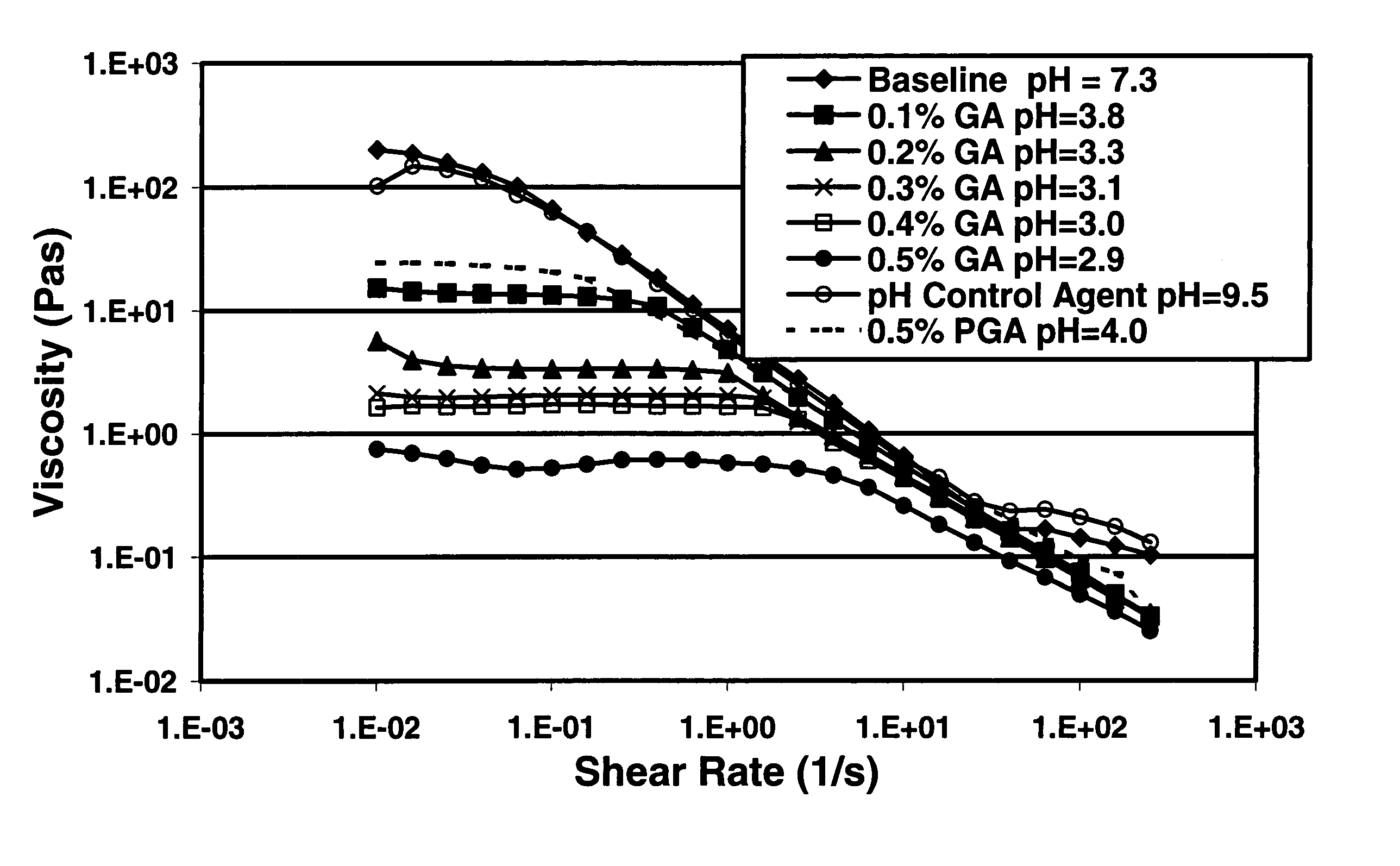Degradable additive for viscoelastic surfactant based fluid systems
a technology of viscoelastic surfactant and additive, which is applied in the direction of fluid removal, well accessories, chemistry apparatus and processes, etc., can solve the problems of undesirable or unacceptable continued presence of filter cake, low viscosity of viscoelastic surfactant system, and high permeability formations that are often poorly consolidated, so as to reduce the viscosity of the viscoelastic surfactant system
- Summary
- Abstract
- Description
- Claims
- Application Information
AI Technical Summary
Benefits of technology
Problems solved by technology
Method used
Image
Examples
example 1
[0057]FIG. 1 shows measurements of the viscosity of one example of a VES fluid system with different amounts of glycolic acid (GA) dissolved in the fluid. Measurements were conducted at 66° C. (150° F.). The pH control agent used in the experiments shown in FIG. 1 was sodium sesquicarbonate, which was used at a concentration of 30 pounds per thousand gallons (3.6 g / L) in all experiments. The VES fluid system was made with 6% of a material called BET-E-40 obtained from Rhodia, Inc. Cranbury, N.J., U.S.A.; it contains a betaine VES surfactant having an erucic acid amide group (including a C21H41 alkene tail group) and is about 40% active ingredient, with the remainder being substantially water, sodium chloride, and isopropanol. (Before use, about 1% of DAXAD 17, a low molecular weight sodium polynaphthalene sulfonate available from Hampshire Chemical Corporation, Nashua, N.H., USA, was added to the as-received betaine surfactant BET-E-40.) This experiment showed the results that would...
example 2
[0059]FIG. 2 shows the viscosity of the same 6% surfactant fluid system as the baseline system of the experiments shown in FIG. 1, determined with a Fann 50 Viscometer over a range of temperatures, with PGA added, with and without the pH 9.5 pH control agent. Without the pH control agent in place, the viscosity of the fluid was substantially reduced; therefore this material would have been unsatisfactory as a viscous oilfield treatment fluid, for example as a fracturing or gravel packing carrier fluid. With the pH control agent present, the viscosity of the fluid system containing the PGA was essentially identical to the viscosity of the baseline system. The total duration of each of these experiments was about 3 hours. At the end of the run with the pH control agent it can be seen that the viscosity dropped below the baseline, suggesting that the hydrolysis of the PGA at the higher temperature was starting to break the fluid when the temperature was above about 121° C. (250° F.). (...
example 3
[0061] Prior to fracturing the lower zone of a well in the Gulf of Mexico, from a mini-fall-off measurement (a simple test in which a viscous fluid is injected, a fracture is created, and the pressure fall-off is observed) it was estimated that the permeability of the sandstone zone that was 16 feet high, was 2.45 mD. The formation temperature was 195° F. (91° C.) and the volume injected was 2329 US gallons (8.82 m 3). The step rate fall off measurement without a solid acid and pH control agent in a VES gave a measured fluid loss coefficient, Ct, of 0.072 ft / min1 / 2. When a solid acid and pH control agent were then placed (4768 US gallons (18.05 m3) of a slurry containing 5 volume percent of BET-E-40 (containing about 1% sodium polynaphthalene sulfonate), 4.8 g / L (40 ppt) of PGA beads about 90% smaller than 20 microns, 4 weight percent KCl, and 4.2 g / L (35 ppt) sodium sesquicarbonate) and a DataFRAC was performed, the measured Ct was reduced in half to 0.035 ft / min½. (A DataFRAC is a...
PUM
| Property | Measurement | Unit |
|---|---|---|
| diameter | aaaaa | aaaaa |
| diameter | aaaaa | aaaaa |
| concentration | aaaaa | aaaaa |
Abstract
Description
Claims
Application Information
 Login to View More
Login to View More - R&D
- Intellectual Property
- Life Sciences
- Materials
- Tech Scout
- Unparalleled Data Quality
- Higher Quality Content
- 60% Fewer Hallucinations
Browse by: Latest US Patents, China's latest patents, Technical Efficacy Thesaurus, Application Domain, Technology Topic, Popular Technical Reports.
© 2025 PatSnap. All rights reserved.Legal|Privacy policy|Modern Slavery Act Transparency Statement|Sitemap|About US| Contact US: help@patsnap.com



